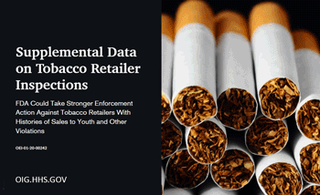Report Materials

About This Product
This product provides state and annual data related to OEI's report Tobacco Retailers: FDA Could Take Stronger Enforcement Action Against Tobacco Retailers With Histories of Sales to Youth and Other Violations.
Why We Did This Study
Youth tobacco use in the United States remains a high public health concern. The Food and Drug Administration’s (FDA’s) Tobacco Retailer Compliance Check Inspection Program is a critical part of its approach to prevent youth access to tobacco. Through that program, FDA inspects tobacco retailers to determine whether they are in violation of tobacco law or regulation. If FDA finds a violation, it may issue an advisory action, such as a warning letter, or an enforcement action, such as a civil money penalty (CMP). Our report assesses FDA’s efforts to oversee tobacco retailers’ compliance with the Tobacco Control Act.
Inspections of tobacco retailers are a critical part of FDA’s efforts to prevent the sale and marketing of tobacco products to youth. The purpose of these inspections is to obtain compliance from retailers by enforcing laws and regulations intended to prevent youth access to tobacco products. Despite FDA’s Retailer Compliance Check Inspection Program having carried out more than a million inspections since 2010, youth tobacco use in the U.S. remains a high public health concern. In particular, e-cigarettes, a type of electronic nicotine delivery system (ENDS), have eclipsed other forms of tobacco to become the most commonly used tobacco product among youth. In 2020, close to 20 percent of high schoolers, or over 3 million students, reported that they currently use e-cigarettes.1 Since then, e-cigarette use among youth may have declined , although a substantial proportion of youth still use these products.
Preventing youth access to tobacco is one of three focus areas of FDA’s Youth Tobacco Prevention Plan, which itself is a component of FDA’s Comprehensive Plan for Tobacco and Nicotine Regulation. Curbing marketing of tobacco products aimed at youth and educating youth on the dangers of tobacco use are the two other focus areas of FDA’s Youth Tobacco Prevention Plan.
What We Found
FDA conducted more than 1 million inspections from 2010 through 2019, by inspecting, at least once, 74 percent of tobacco retailers that were in business nationwide as of 2020. FDA almost always returned to inspect retailers where it found violations within 12 months. In some states and territories (hereinafter States), inspection activities were correlated with neighborhoods’ socioeconomic conditions, raising questions about how FDA and its contractors select retailers to inspect. Overall, FDA’s actions against retailers that violated tobacco laws and regulations were in accord with its policies.
However, retailers with histories of violations were often not subject to the strongest enforcement actions. FDA collected the full amount for only 9 percent of the CMPs it issued to retailers with histories of violations compared to 60 percent of CMPs it issued to retailers with fewer violations. Also, retailers in our sample that could have been subject to a no-tobacco-sale order (NTSO) usually did not receive one. However, we did not determine the extent to which FDA’s consideration of mitigating factors or actions by Administrative Law Judges played a role in these outcomes.
1 FDA notes that the 2021 National Youth Tobacco Survey (NYTS) was fully conducted amid the global COVID-19 pandemic, during which time eligible students could participate in the survey in classrooms, at home, or at some other place. Thus, estimates from the 2021 NYTS should not be compared with previous NYTS survey waves that were primarily conducted on school campuses.
Explore the Tobacco Oversight Topic Page on OIG's GeoHub.
Notice
This report may be subject to section 5274 of the National Defense Authorization Act Fiscal Year 2023, 117 Pub. L. 263.
